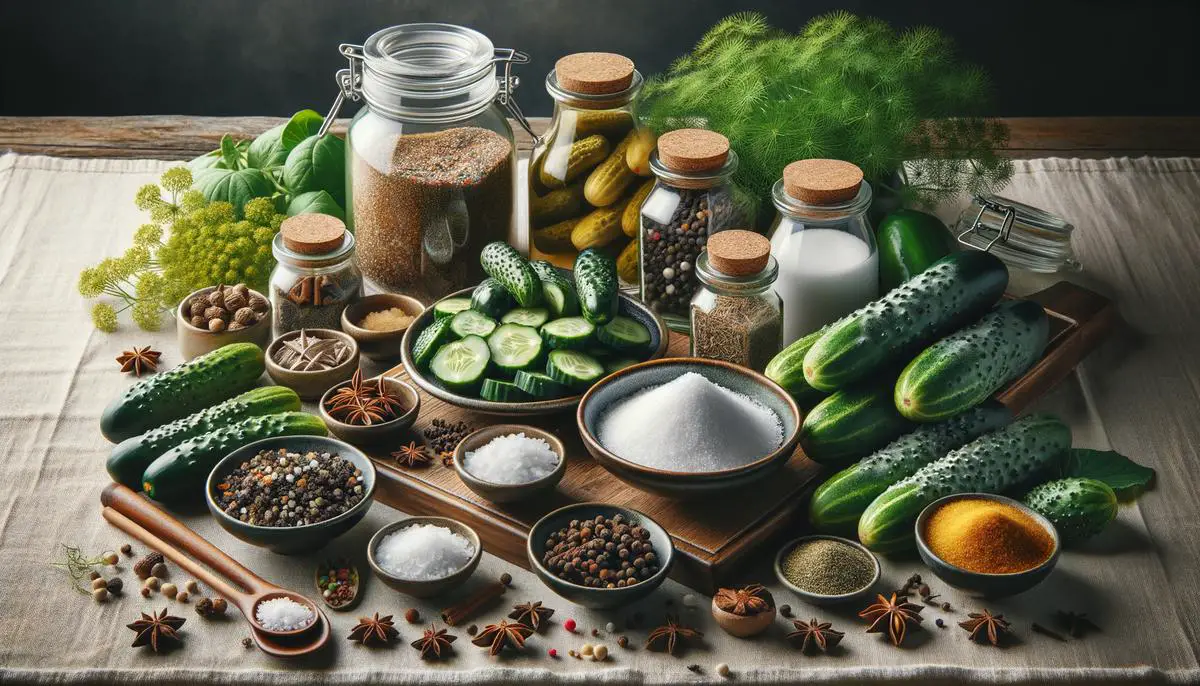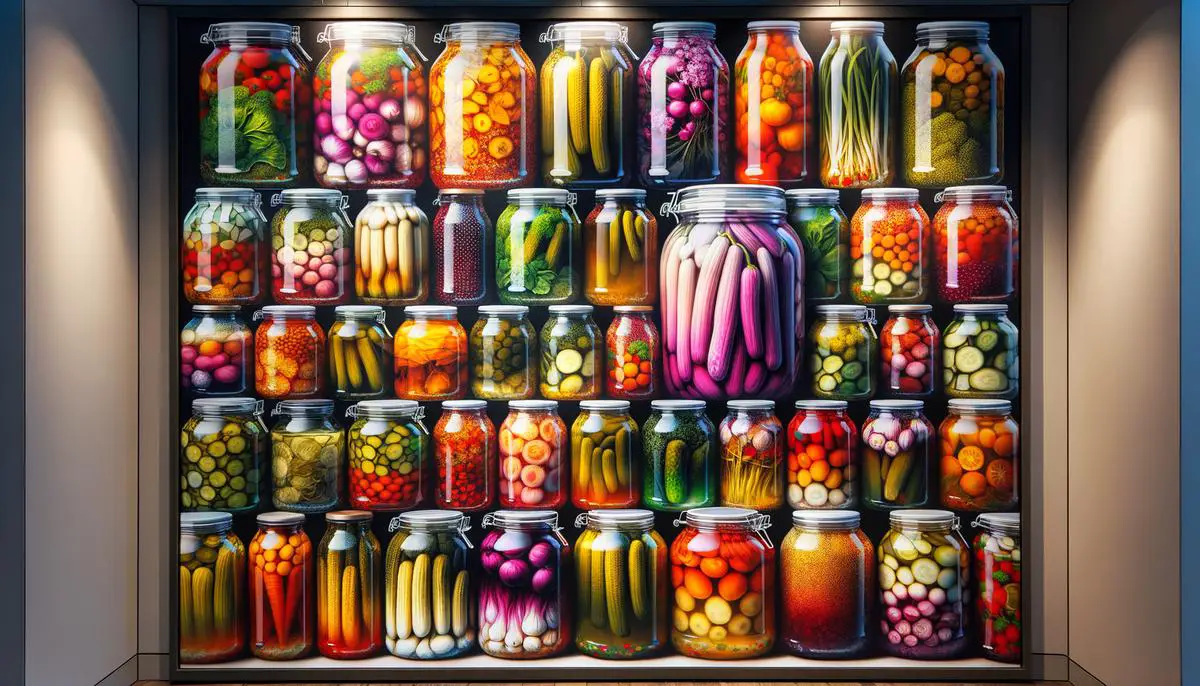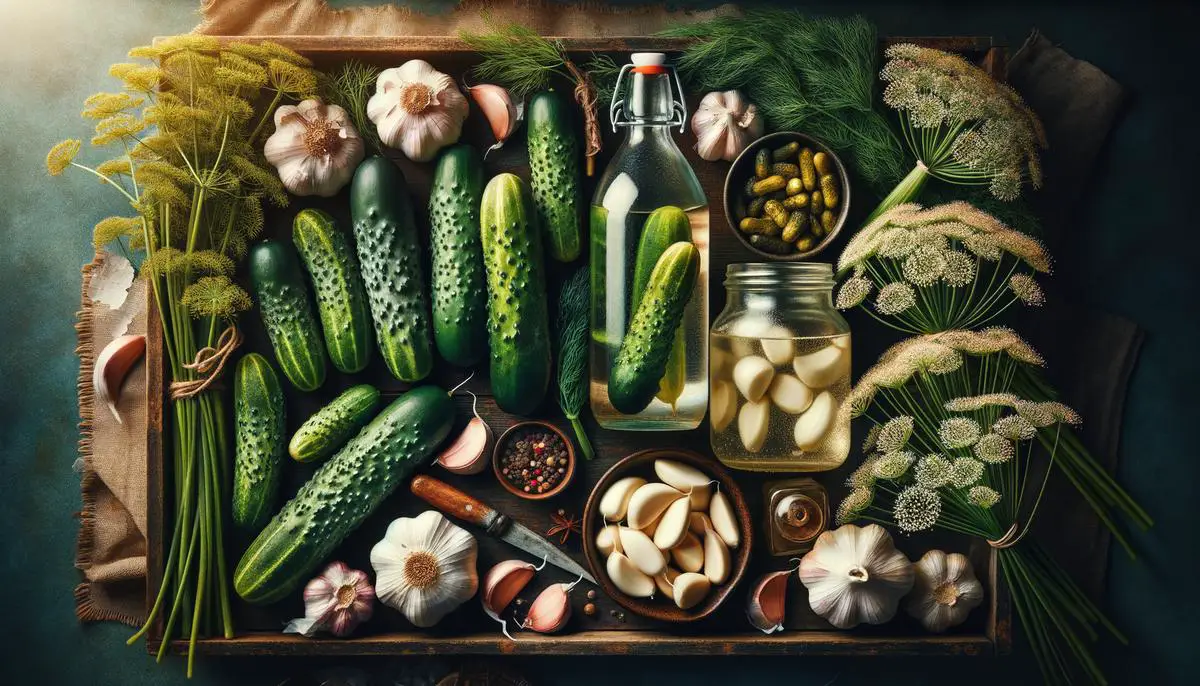Stepping into the kitchen with a basket of fresh produce and a spirit ready for adventure, we begin a journey not just of preserving food but of crafting flavors that tell stories. This gentle foray into pickling isn’t just about combining vinegar, salt, and spices; it’s about the artistry and science behind transforming simple ingredients into treasures of taste. As we prepare to weave through the steps and ingredients necessary for creating pickles that could very well become the talk of your table, remember, the essence of this process lies in patience and creativity.
Choosing Your Ingredients
Jumping right into the midst of pickling necessities, grab yourself some crisp cucumbers because they act as the spine of traditional pickle recipes. This crunchy veggie is your canvas, ready to soak up flavors and transform into the star of your pickling show.
Got your cucumbers? Good. Next up, vinegar steps into the spotlight. It’s this acidic marvel that does the heavy lifting, preserving your pickles and gifting them with their signature puckery taste. White vinegar is a go-to for its clean, sharp flavor, but don’t be shy to dabble with apple cider vinegar for a mellow, fruity twist.
Now, unless you fancy tasteless pickles, salt isn’t just important — it’s indispensable. But tread carefully: not all salts are created equal for pickling. Fine sea salt or pickling salt carries your pickles to victory, keeping them firm and flavorful without the bitter friend known as iodine coming to crash the party.
Dancing into this mix comes sugar. Ah, sugar, not always necessary, but when it is, it balances vinegar’s tartness and coaxes out the natural sweetness of your vegetables. If you’ve got a sweet tooth, consider this ingredient your secret weapon.
Spices and herbs? Absolutely. Without them, your pickles might as well be taking a long nap— flavorless and unexciting. Dill and garlic are classic choices, promising a friendly punch of aroma and taste to wake those pickles right up. But why stop there? Mustard seeds, peppercorns, coriander seeds—they all queue up to add depth and distinctiveness to your creations.
Water is often overlooked yet it serves as the womb of the pickling process, working closely with vinegar to create the brine. For crystal clear pickles that would make any grandmother proud, stick with distilled water. It’s devoid of minerals that could turn your once-aesthetically-pleasing jar a muddy hue.
Now, gather these elements together and you have the foundation of a pickling powerhouse. But let’s not forget one final actor in this drama: jars. Clean, airtight jars ensure your pickles remain preserved and tasty for months. Sterilize them to keep the unwanted gift of bacteria from spoiling your hard work.
There you have it: your toolkit to begin the flavorful voyage of home pickling. With these components at the ready, adventure is right around the corner—or in this case, in your very kitchen. Let the bold symphony of tastes begin.

The Pickling Process
Shifting gears, let’s focus on the preparation phase that often goes unnoticed but is crucial for a successful pickle making. Begin with selecting fresh, crisp vegetables aside from cucumbers, like carrots, radishes, or green beans. The fresher the produce, the crunchier your pickles will be.
Next, it’s essential to cut your vegetables consistently. Whether you’re making spears, slices, or chunks, ensuring uniformity in size helps in even pickling. Remember, thinner slices or smaller pieces mean quicker pickling time.
Now, let’s dive into the brining solution’s temperature, which varies based on the pickling method you’re following. For those in pursuit of quick pickles, a heated brine is key. Heating your vinegar mix dissolves the salt and sugar faster and allows spices to release their flavors more intensely into the mixture. On the other hand, cold brine works better for ferments, where a slower, more natural pickling process is desired.
Speaking of methods, let’s demystify two popular ones—hot water bath canning and quick pickling. Hot water bath canning is the go-to for long shelf life. It involves filling sterilized jars with your pickles and covered with hot brine, then sealing them in a water bath. This process kills off bacteria and seals the jar, making your pickles last for up to a year.
Contrary, quick pickles or refrigerator pickles are way simpler and don’t require any fancy equipment. Just pour your hot brine over the arranged vegetables in a jar, seal it up once cooled, and chuck it into the fridge. In just a few days, these easy-to-make pickles offer a crunchy, flavorful addition to any meal. Although they must be consumed within a month and kept refrigerated, their ease and speed of preparation make them a standout choice for beginners or those looking for a quick pickle fix.
When tinkering with flavors, don’t shy away from experimentation. While traditional spices are staples for a reason, exploring with aromatics like cinnamon sticks, bay leaves, or even a slice of fresh ginger can introduce a whole new flavor profile to your pickles. The idea is to find the right balance that appeals to your taste buds.
Lastly, patience plays a part in pickling perfection. Regardless of the method you choose, allowing your pickles to sit for at least 48 hours before diving in helps flavors to mature and develop fully. Giving them this time means a more satisfying crunch and a deeper, more complex flavor.
With these steps clear, you’re well-equipped to wade into the waters of home pickling. Remember, every batch is an opportunity to tweak and perfect your recipe, making each jar a reflection of your evolving pickling prowess. So, don’t fret the missteps; instead, see them as stepping stones to your next pickle masterpiece. Happy pickling!

Creative Pickling Ideas
Dive deeper into the pickling pot by venturing into the world of fruit pickles. That’s right, beyond the realm of veggies, fruits like cherries, grapes, and even peaches can transform into tangy treats that tantalize the palate. Imagine biting into a spicy pickled cherry or a cinnamon-laced pickled peach; these snacks can elevate cheese boards or desserts to a new level of delicious complexity.
Let’s shift gears to the brine’s composition – not all pickles need walk the path of acidity and salt. For a sweet-and-sour sensation, why not swap in some honey or maple syrup for sugar? This switch invites a whole new spectrum of flavors to play, complementing the natural sweetness of fruits and counterbalancing the tang of vinegar. Reflect on incorporating different types of honey with their unique profiles – from wildflower to clover – each promises a distinct, sweet twist to your pickle brine.
And why limit oneself to vinegar-based pickles when fermenting opens a whole new door? Fermenting fruits and vegetables, such as kimchi-style fermented carrots or sauerkraut-style fermented apples, introduces beneficial probiotics and offers a delectably tangy flavor without vinegar. This process takes time and patience but yields a rich flavor and texture that’s impossible to replicate with quick pickling methods. Consider adding some gochujang or miso paste for some ferments to infuse depth and a kick of unique flavor.
Exploring uncommon vegetables and fruits for pickling brings surprise and delight; radishes, asparagus, and pearl onions transform beautifully in brine, offering crisp bites that are both zesty and refreshing. But why not take a step further into the unconventional? Consider pickling avocados for a creamy, tangy treat or mango strips for a sweet, spicy, and sour snack that dances on the tongue.
In playing with temperature, cold pickles create sharp, refreshing contrasts in texture and flavor, ideal for summer salads or as condiments. Try chilling your pickles promptly after brining for a crisp, invigorating bite that’s distinctly different from their room-temperature counterparts.
Spice mixes can dramatically alter the audience of your pickles. Crafting signature spice blends allows you to stamp your culinary identity on your creations. Think saffron and rosewater for a Middle Eastern influence or turmeric and curry leaves for an Indian-inspired batch. These unique blends can transform even the simplest of pickles into globetrotting gourmet delights.
For those seeking a playful project or a memorable gift, mini watermelon rinds pickled with jalapeño and lime offer both visual charm and zesty flavor. Such creations prove that with a dash of creativity, pickling can be as much an art as it is a science.
Winding down, reflect on pairing your finished pickles with food. For example, pickled strawberries make an intriguing companion to rich, creamy cheeses, while pickled red onions elevate tacos or grilled meats with their sassy crispness.
Let this journey through pickling encourage you not just to follow recipes but to perceive them as canvases for creation. With each batch, you tweak and tailor; you’re harnessing the boundless possibilities that pickling offers. In crowning your jars with bespoke labels, you celebrate not only the joy of making but also of sharing, as each jar encapsulates a piece of your culinary voyage, ready to spread joy and surprise to all who twist them open.

In wrapping up our journey through the art of pickling, let’s circle back to the core of what makes this adventure so rewarding. Beyond the jars, brine, and spices lies the true heart of pickling – the joy of creation and the anticipation of sharing these culinary delights with others. Whether it’s a crunchy cucumber or a tangy piece of fruit, each pickle jar is a testament to the care and creativity poured into it. So, as you stand in your kitchen pondering your next batch, remember that each ingredient, each spice blend, is a brushstroke in your ever-growing gallery of homemade wonders.
